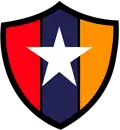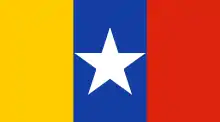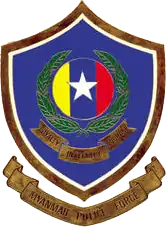Myanmar Police Force
The Myanmar Police Force (မြန်မာနိုင်ငံရဲတပ်ဖွဲ့) is the law enforcement agency of Myanmar. Formally known as the People's Police Force (ပြည်သူ့ရဲတပ်ဖွဲ့), it was established in 1964 as an independent department under the Ministry of Home Affairs. It was reorganised on 1 October 1995 and informally became part of the Tatmadaw (Armed Forces of Myanmar).
| မြန်မာနိုင်ငံရဲတပ်ဖွဲ့ | |
 Official emblem | |
 Flag of the MPF | |
 Coat of arms | |
| Agency overview | |
|---|---|
| Formed | 1964 |
| Superseding agency | |
| Type | Law enforcement |
| Jurisdiction | Myanmar |
| Headquarters | Naypyidaw |
| Employees | 93,000 |
| Minister responsible |
|
| Agency executive |
|
| Parent agency | Ministry of Home Affairs |
| Child agencies |
|
| Website | Official website |
History
The Police Force in Myanmar have an extensive history; the police force also includes local police and regional police in different jurisdictions.
British rule in Myanmar
The Indian Imperial Police was the primary law enforcement in Burma until 1937, when it was split from British India.
In 1872 the third mayor of Mergui District, Sir Ashly Din (1870-1875) assigned the first police officer to be stationed at Maliwan, a village 24 miles north of current Victoria Point.
Perhaps the most famous policeman in Burma from this period is the author George Orwell, who in 1922 joined the Indian Imperial Police in Burma.
Post-independence (1948–present)
.jpg.webp)
On 16 March 1988 following the killing of two students during the pro-democracy demonstrations, students marching on Prome Road were confronted near Inya Lake by the Lon Htein security force riot police and many beaten to death or drowned.
The national police are made up of several smaller entities, including
- Myanmar Railways Police
- Intelligence division
Organisation
The current Director General of Myanmar Police Force is Police Lieutenant General Aung Win Oo with its headquarters at Nay Pyi Daw. Its command structure is based on established civil jurisdictions. Under the command of Police Headquarter, State and Region Police force have been established in respective territories of states and divisions with headquarters in their capital cities.[2]
State and Division Police Forces
There are 14 State and Divisional Police Forces and three additional State/Division Police Forces commanded by Police Brigadiers or Colonels. Their jurisdictions are divided according to the Civil Administration. The States and Divisions, Additional States have the same status.
Each State and Divisional Police Force consist of four components.
- Office of the Commander of the State and Divisional Police Force
- Office of the Commander of the District Police Force
- Office of the Commander of the Township Police Force
- Police Stations
In previous time, the District Police Forces are classified into two classes depending on the area, population and development, namely A and B Class. Commanders of the A Class District Police Forces are Police Lieutenant Colonels and B Classes are Police Majors but there is no classification and all districts assigned with Lieutenant Colonel. Commanders of Township Police Forces are Police Majors and Police Station Officers are Police Captains.
Special Departments
There are four Special Departments, in which the first ten Departments are headed by the Police Brigadier Generals and the remaining two are by Police Colonels.
- Security Police Force
- Border Guard Police Force
- Special Intelligence Department (Special Branch)
- Criminal Investigation Department (CID)
- Railways Police Department
- Anti-human Trafficking Police Force
- Maritime Police force
- Aviation Police Force
- Drug Enforcement Division
- Financial Investigation force
- Myanmar Traffic Police
- Tourist Security Police Force
- Oil Field Security Police Force
- Forestry Security Police Force
- Highway Police Force
- Municipal Police Department
Training Centres
There are three main Training Centers, one Central Training Institute of Myanmar Police Force and Three Police Training Depots. The State and Divisional Police Forces have their own training centres for refresher courses and Junior Leader (NCO) Courses.
Bachelor's degree holders from Distance Learning University were disqualified from sitting the SIP exam. Thus vast numbers of Bachelor holding police personal were concerned for their future.
| Course Name | Duration |
|---|---|
| Deputy Superintendent Cadet Course | 50 weeks |
| Sub-Inspector Cadet Course | 6 weeks |
| Surveillance Officer Course | 6 weeks |
| Investigation Officer Course | 6 weeks |
| Police Station Officer Course | 8 weeks |
| Staff Officer Course | 6 weeks |
| Township Police Commander Course | 8 weeks |
| District Police Commander Course | 12 weeks |
No. 1 Police Training Depot
The No.1 Police Training Depot is commanded by a Police Lieutenant Colonel and undertakes:
| Course Name | Duration |
|---|---|
| Basic Training Course for Lance Corporal and Corporal | 4 weeks |
| Warrant Officer and Police Sergeants Course | 12 Weeks |
| Basic Training Course for Constables | 24 weeks |
| Clerical Training | 4 weeks |
| Instructor Renewal Course | 4 weeks |
No. 2 Police Training Depot
The No.2 Police Training Depot is also commanded by a Police Lieutenant Colonel, and undertakes only Basic Training Course for Constables, which normally takes around 6 months to complete.
| Course Name | Duration |
|---|---|
| Basic Training Course for Constables | 6 Months |
Taung Lay Lone Police Training Depot
The Taung Lay Lone Police Training Depot is commanded by a Police Lieutenant Colonel and undertakes:
| Course Name | Duration |
|---|---|
| Basic Training Course for lance corporal and Corporal | 4 weeks |
| Warrant Officer and Police Sergeants Course | 12 Weeks |
| Basic Training Course for Constables | 6 Months |
Combat Police Battalions (SWAT)
There are sixteen Police Battalions to carry out general security duties under the command of Battalion Control Command. The Battalion Commandants are Police Lieutenant Colonels. As the populace of the cities including Yangon and Mandalay have been increased day after day, problems on social, economy and politics are risen up that could lead to emergence of civil unrest and sabotage. It is necessary to prevent from destruction and harassment, VIP and project factories and workshops, security of diplomats and their embassies. Seven of these Police Battalions are situated in the Yangon Divisional areas and two in Mandalay and three in Arakan, one in Sagaing, one in Mon State, one in Pegu, one in Prome.
These specially-trained and combat capable battalions are formed with personnel from former Riot Security Police, better known as "Lon Htein" Units. Each battalion consists of 500+ personnel and these battalions are supported by two support battalions, which include signal and medical units. These battalions structure are similar to that of Army's Light Infantry Battalions and they are subordinate to their respective Regional Military Commands.[3]
- 1st Combat Police Battalion (HQ at Hlawga)
- 2nd Combat Police Battalion (HQ at Maungtaw)
- 3rd Combat Police Battalion (HQ at Shwemyayar)
- 4th Combat Police Battalion (HQ at Shwesaryan)
- 5th Combat Police Battalion (HQ at Hmawbi)
- 6th Combat Police Battalion (HQ at Shwepyitha)
- 7th Combat Police Battalion (HQ at Kyauktan)
- 8th Combat Police Battalion (HQ at Mingaladon)
- 9th Combat Police Battalion (HQ at Hlaingthaya)
- 10th Combat Police Battalion
- 11th Combat Police Battalion
- 12th Combat Police Battalion
- 14th Combat Police Battalion (HQ at Pa Lake, Mandalay)
- 15th Combat Police Battalion
- 16th Combat Police Battalion
Anti-Narcotic Task Forces
26 special anti-narcotic task forces have been established under the direction of the Central Committee for Drug Abuse Control.
Rank structure and insignia
Commissioned officers
| Equivalent NATO code | OF-10 | OF-9 | OF-8 | OF-7 | OF-6 | OF-5 | OF-4 | OF-3 | OF-2 | OF-1 | OF(D) and student officer | |||||||||||||||||||||||||
|---|---|---|---|---|---|---|---|---|---|---|---|---|---|---|---|---|---|---|---|---|---|---|---|---|---|---|---|---|---|---|---|---|---|---|---|---|
| No equivalent |  |
 |
 |
 |
 |
 |
 |
 |
 |
 |
 | |||||||||||||||||||||||||
| Police General ရဲဗိုလ်ချုပ်ကြီး |
Police Lieutenant General ဒုရဲဗိုလ်ချုပ်ကြီး |
Police Major General ရဲဗိုလ်ချုပ် |
Police Brigadier General ရဲမှူးချုပ် |
Police Colonel ရဲမှူးကြီး |
Police Lieutenant Colonel ဒုရဲမှူးကြီး |
Police Major ရဲမှူး |
Police Captain ဒုရဲမှူး |
Police Lieutenant ရဲအုပ် |
Police Sub-Lieutenant ဒုရဲအုပ် |
Police Cadet ရဲအရာရှိလောင်း | ||||||||||||||||||||||||||
Enlisted ranks
| Equivalent NATO Code | OR-9 | OR-8 | OR-7 | OR-6 | OR-5 | OR-4 | OR-3 | OR-2 | OR-1 | |||||||||||||||||||||||||||
|---|---|---|---|---|---|---|---|---|---|---|---|---|---|---|---|---|---|---|---|---|---|---|---|---|---|---|---|---|---|---|---|---|---|---|---|---|
| No equivalent |  |
No equivalent |  |
 |
No insignia | |||||||||||||||||||||||||||||||
| Police Warrant officer ဒုအရာခံဗိုလ် |
Police sergeant တပ်ကြပ်ကြီး |
Police corporal တပ်ကြပ် |
Police lance corporal ဒုတပ်ကြပ် |
Policeman | ||||||||||||||||||||||||||||||||
Weapons and equipment
Myanmar Police Force uses wide range of weapons and ammunitions, ranging from Second World War vintage to modern sophisticated weapons. Most of the weapons are either seized from ethnic wars and narco-insurgents or locally produced copies of the G3 and other weapons phased out of their army.
SWAT battalions are armed with relatively modern small arms and members of MPF who are stationed in local police stations within States and Divisional Police Forces and those providing general guard duties at various government establishments and public places such as airports, train and bus stations, along with officers and detectives, are issued with Second World War vintage weapons.
Sub machine gun
- Heckler & Koch MP5 (Norinco made NR-08)
- Ka Pa Sa BA-52
- Sten Gun
- BA93
- BA94
- MA13 MKI
- MA13 MKII
Rifles
Machine gun
- Bren Gun
- Ka Pa Sa BA64
- Ka Pa Sa MA12
- Type 81 lmg (sized from narco ethinc insurgents)
- Type 56 lmg (sized from narco ethnic insurgents)
Sniper rifle
- M40 rifle (seized from ethnic and narcotic insurgents)
- Ka Pa Sa BA100
- Ka Pa Sa MAS MKII
Non-Lethal Weapons
Cars and Trucks
- Mitsubishi Pajero (confiscated item),
- Chevrolet Suburban (confiscated item),
- Range Rover donated by Foreign Organisations for Anti-drugs Enforcement,
- Mercedes Benz C-Class sedan (confiscated item),
- Toyota Dyna paddy wagon (Private owned vehicles are commonly called as volunteers patrol cars),
- Toyota closed double cab (confiscated item, used by escort team, patrol),
- Mitsubishi double cab (confiscated item, used by Police Col, Yangon),
- Mitsubishi pickup (confiscated item, used by Township Police Station, Yangon),
- Mitsubishi pickup (confiscated item, used by Police Lt Col, Yangon),
- Toyota pickup (confiscated item, used by Township Police Station, Yangon),
- FAW pickup,
- Honda Saloon, Patrol car,
- Jeep, Used by police station,
- Mazda B pick-up, Used by police station,
- Toyota Celica, used as a police lead vehicle and as a high-speed police car to arrest sport cars,
- Nissan Fairlady Z, used as a police lead vehicle and as a high-speed police car to arrest sport cars.
Motorcycles
- Harley-Davidson motorcycle (For Pilot and Point)
- Qingqi motorcycle (these motorcycles were used by motor vehicles police, Township Police and their informer illegal and without registration number)
Coastal Patrol Craft
| Class | Builder | Serial Number | Year Entered Service | Armament | Note |
|---|---|---|---|---|---|
| PGM class | 331 332 333 334 | 2012 | machine guns | ||
Awards, commendations, citations and medals
References
- "မြန်မာနိုင်ငံရဲတပ်ဖွဲ့ ရဲချုပ် ခန့်အပ်တာဝန်ပေးခြင်း". Retrieved 25 July 2013.
- http://www.myanmar.gov.mm/ministry/home/mpf/%5B%5D
- Selth, Power Without Glory
External links
| Wikimedia Commons has media related to Police of Myanmar. |